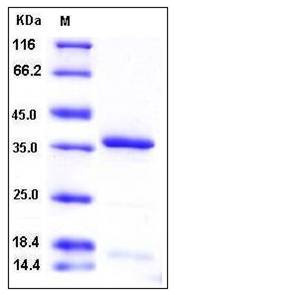Human HTRA2 / OMI Protein (His Tag)
OMI, PARK13, PRSS25
- 100ug (NPP3931) Please inquiry
| Catalog Number | P10619-H08E |
|---|---|
| Organism Species | Human |
| Host | E. coli |
| Synonyms | OMI, PARK13, PRSS25 |
| Molecular Weight | The recombinant human HTRA2 consisting of 336 amino acids and has a calculated molecular mass of 36.5 kDa as estimated in SDS-PAGE under reducing conditions. |
| predicted N | Met |
| SDS-PAGE |  |
| Purity | > 87 % as determined by SDS-PAGE |
| Protein Construction | A DNA sequence encoding the mature form of human HTRA2 (O43464-1) (Ala 134-Glu 458) was expressed, with a polyhistide tag at the C-terminus. |
| Bio-activity | Protease activity demonstrated by HtrA2 cleavage of bovine β-casein (Sigma, Catalog # C-6905). Incubation of β-casein at 0.2 mg/mL with Recombinant Human HTRA-2 at 0.02 mg/mL (ratio of 10:1) for 60 minutes at 45℃ in 50 mM Tris, pH 8.0, which results in >95% cleavage of β-casein, as revealed by SDS-PAGE. |
| Research Area | Immunology |Signal Transduction |Signaling Pathway |Representative pathway |Apoptosis Signaling pathway |Inhibitors of Apoptosis (IAPs) and Regulators | |
| Formulation | Lyophilized from sterile 50mM Tris, 0.3M NaCl, 1mM DTT, 20% Glycerol, pH 7.8 1. Normally 5 % - 8 % trehalose and mannitol are added as protectants before lyophilization. Specific concentrations are included in the hardcopy of COA. |
| Background | Serine protease HTRA2, also known as high temperature requirement protein A2, Omi stress-regulated endoprotease, Serine protease 25, Serine proteinase OMI and HTRA2, is a single-pass membrane protein which belongs to the peptidase S1B family. HTRA2 contains one PDZ (DHR) domain. HTRA2 is a serine protease that shows proteolytic activity against a non-specific substrate beta-casein. It promotes or induces cell death either by direct binding to and inhibition of BIRC proteins (also called inhibitor of apoptosis proteins, IAPs), leading to an increase in caspase activity, or by a BIRC inhibition-independent, caspase-independent and serine protease activity-dependent mechanism. HTRA2 cleaves THAP5 and promotes its degradation during apoptosis. Isoform 2 of HTRA2 seems to be proteolytically inactive. Defects in HTRA2 are the cause of Parkinson disease type 13 (PARK13) which is a complex neurodegenerative disorder characterized by bradykinesia, resting tremor, muscular rigidity and postural instability, as well as by a clinically significant response to treatment with levodopa. |
| Reference |
